This post may contain affiliate links. Please read my privacy policy.
Authentic and easy Mapo Tofu recipe, with soft silken tofu cooked in a spicy, numbing, savory, and aromatic Mapo Tofu sauce with ground pork. This recipe is fail-proof and beginner-friendly.
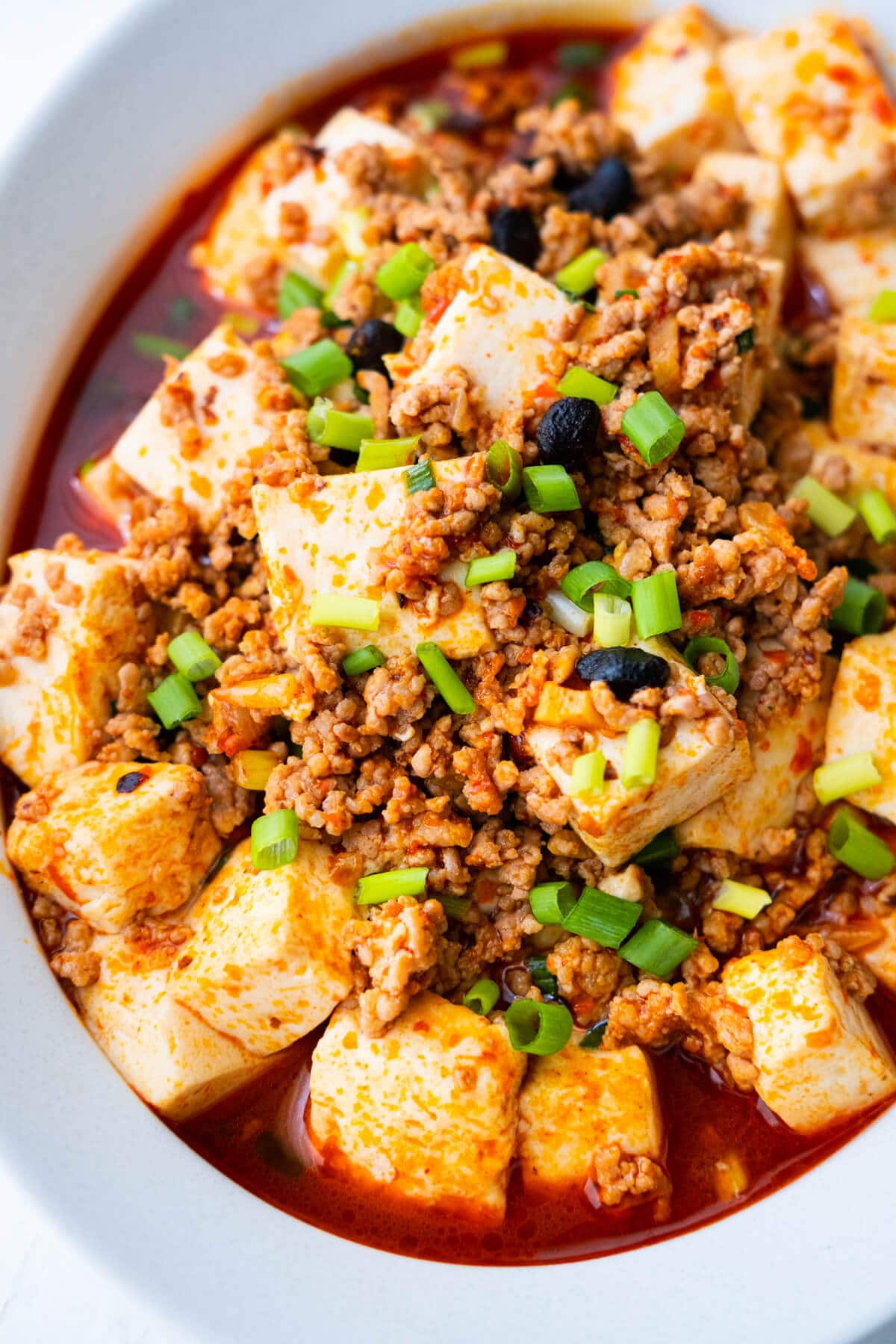
What Is Mapo Tofu
Mapo Tofu is a popular Chinese dish from Sichuan, featuring soft tofu in a spicy and savory sauce, often with minced pork or beef. The name “Mapo Tofu” (麻婆豆腐) translates to “pockmarked old lady tofu,” inspired by the woman who first made it in Sichuan province, China.
The “mala” (麻辣) Mapo Tofu sauce, combining “má” (麻 for numbing) and “là” (辣 for spicy), creates a unique and exciting taste experience. This flavor profile tingles the palate, increasing appetite and providing a deeply satisfying eating experience, akin to other popular Sichuan dishes such as red oil wontons, Sichuan beef, and Sichuan cabbage.
The texture of Mapo Tofu is as appealing as its taste, with soft tofu soaking up the spicy sauce, offering a smooth, creamy contrast. Ground meat adds texture, while fresh chopped scallions add color and freshness to complete the dish.
Easy Mapo Tofu Recipe
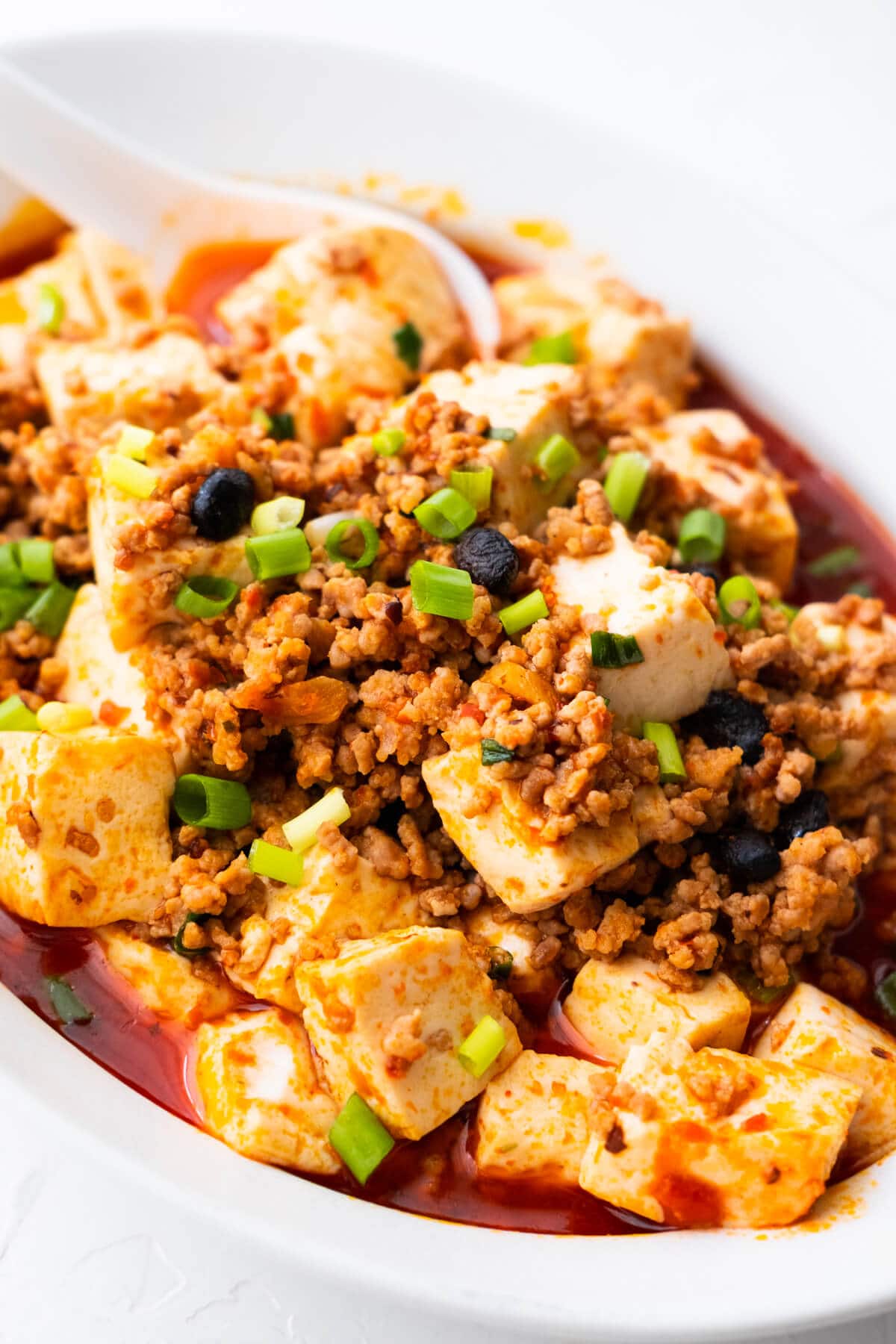
Today, Mapo Tofu is as common in Chinese restaurants and as popular for takeout as Kung Pao Chicken. Despite its rich flavors, it’s surprisingly easy to make at home. I’ll show you how to recreate this dish in your own kitchen, just like your favorite Chinese restaurant.
If you’re new to Chinese cooking, don’t worry! My authentic recipe for Mapo Tofu is straightforward, and anyone can make it at home. You don’t need to rely on store-bought Mapo Tofu mix for this dish. My recipe calls for only 3 simple steps. Just follow my cooking guide below, and you’ll have a delicious serving of this renowned tofu dish right at home!
Recipe Variations
This recipe is versatile because you can adjust the proteins and vary the levels of numbing (ma) and spicy (la) flavors to suit your preferences. Here are two protein substitutions:
- Vegetarian/Vegan Mapo Tofu: To make a vegetarian or vegan version, replace the ground pork or beef with minced mushrooms, particularly shiitake mushrooms for their deep umami flavor. You can use fresh shiitake mushrooms or rehydrate dried ones by soaking them in hot water for 15-20 minutes until plump. Save the soaking liquid to enhance the dish’s richness.
- Seafood Mapo Tofu: For a seafood twist, add diced shrimp, scallops, or a combination of both to your Mapo Tofu. This variation introduces a rich and briny taste that complements the tofu well.
In Japan and Korea, Mapo Tofu is also popular, especially within their Chinese communities. In Japan, it’s known as Mabo Dofu, which has a milder spice level and uses ingredients like soy sauce, miso, and dashi for a savory, slightly sweet flavor.
In Korea, known as Mapadubu or Mapa Tofu, it’s spicier due to Korean chili flakes or gochujang, adding a distinct spicy note. Korean versions may include additional ingredients like doenjang (fermented soybean paste) or sesame oil for extra depth of flavor.
Both adaptations cater to local tastes and are staples in Chinese restaurants in Japan and Korea, often found in Chinatowns in both countries.
Mapo Tofu Ingredients
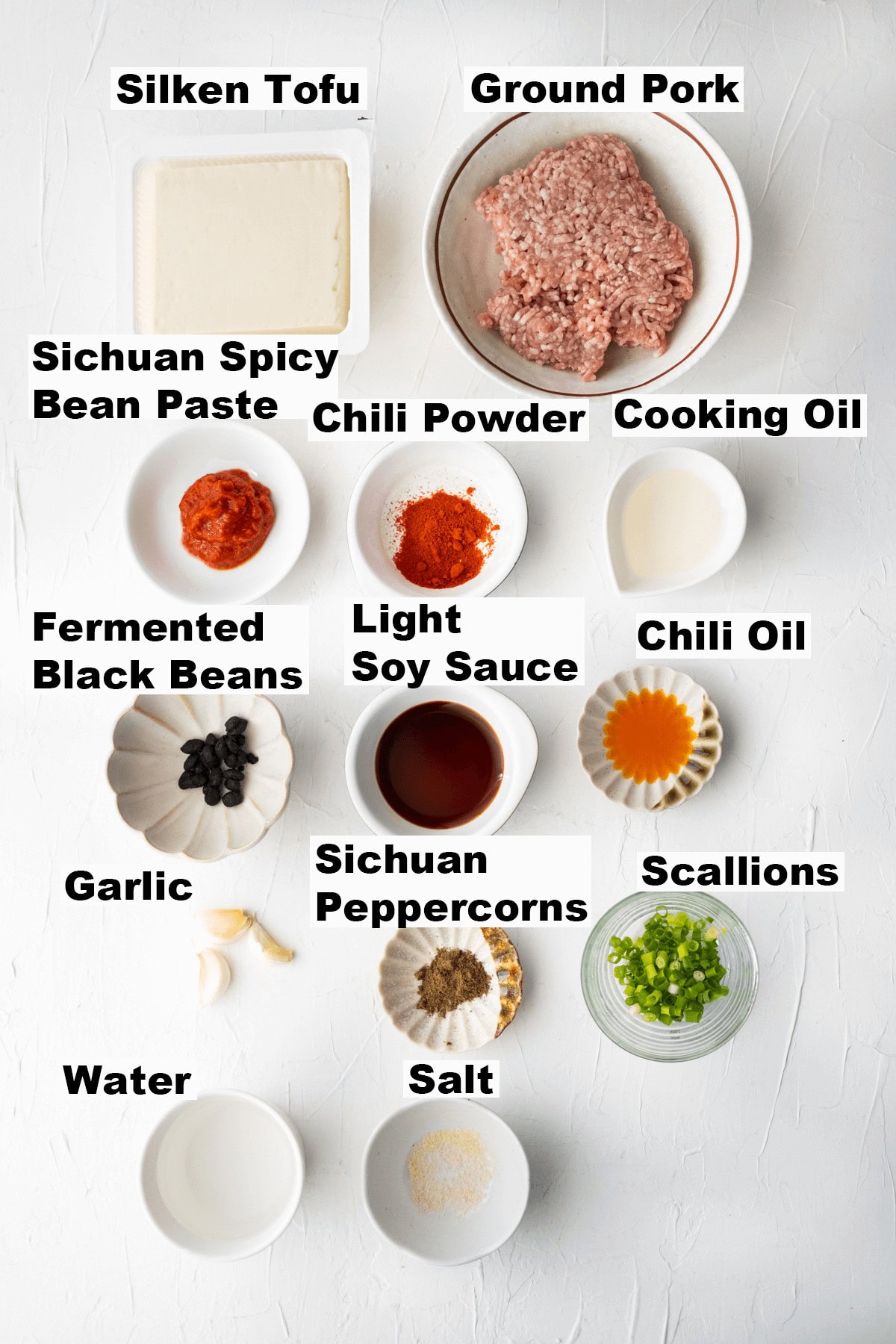
My recipe includes the following ingredients, creating a spicy and savory dish with a unique numbing sensation.
- Silken tofu.
- Ground pork or beef. I prefer ground pork for this recipe.
- Cooking oil and chili oil.
- Garlic
- Soy sauce
- Scallion
Mapo Tofu Sauce
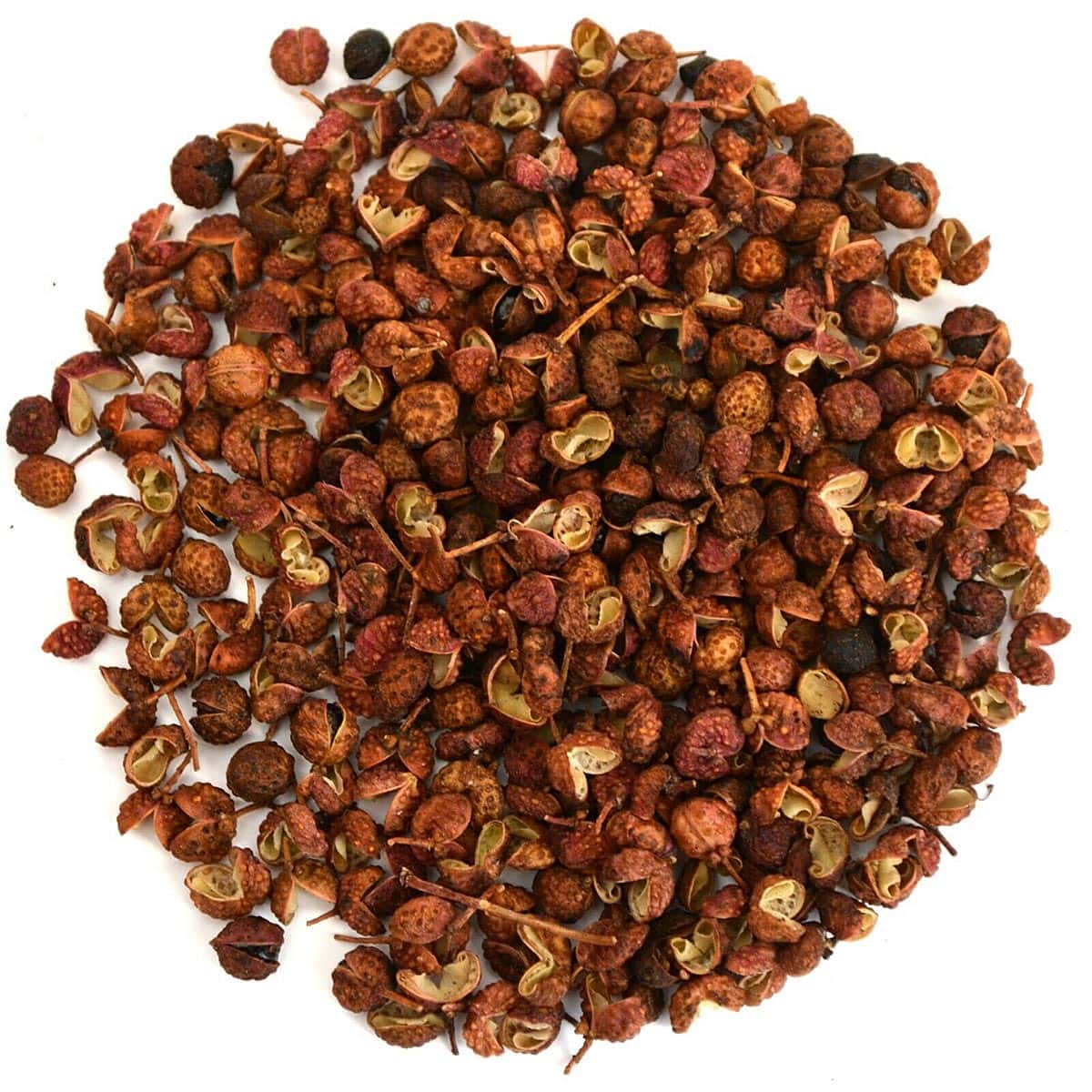
The sauce is the heart of this flavorful dish, known for its bold and distinctive taste. Here are the list of ingredients for the sauce:
- Spicy bean sauce. Called Doubanjiang in Chinese, this lends the savory and spicy flavor in the sauce.
- Chili powder: Adds the iconic fiery heat to the recipe.
- Fermented black bean. Called Douchi in Chinese, they are used in various Chinese recipes. They are paired with the spicy bean paste, chili oil cand chili powder to create the robust mapo tofu sauce.
- Sichuan peppercorns: Called huajiao (花椒) in Chinese language, Sichuan peppercorn is the secret ingredient of Mapo Tofu due to its numbing effect and aromatic flavor.
- Soy Sauce: Adds rich, deep umami.
Chinese Ingredients Buying Guide
Shopping Tips: In the United States, Chinese pantry ingredients can be purchased at large Asian supermarket chains like 99 Ranch Market and H Mart. For Spicy Bean sauce, I recommend the Lee Kum Kee brand, which is marketed as Chili Bean Sauce (Toban Djan).
See the recipe card for full information on ingredients.
How To Make Mapo Tofu
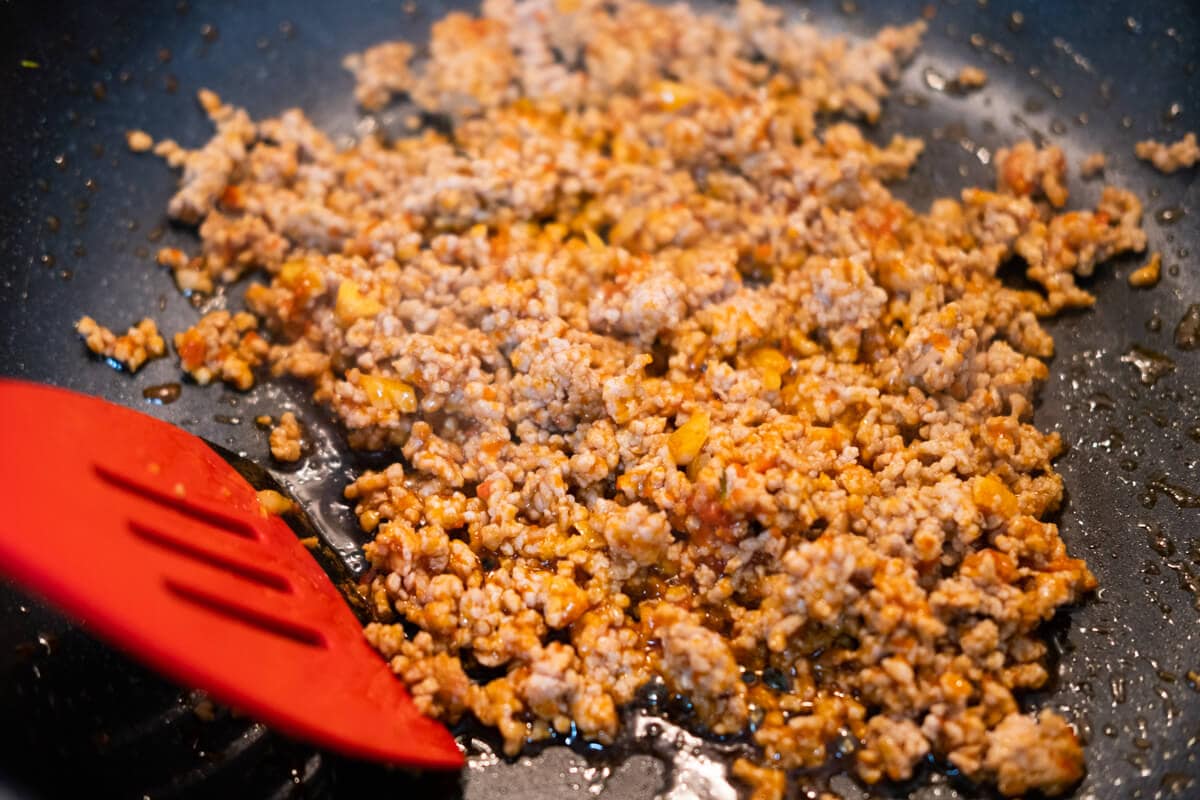
Step 1. Cut the tofu into small pieces, drain any excess water from it, and set aside. Heat a wok, then add cooking oil and chili oil. Stir-fry chopped garlic, ground pork, and spicy bean paste until the pork is halfway cooked.
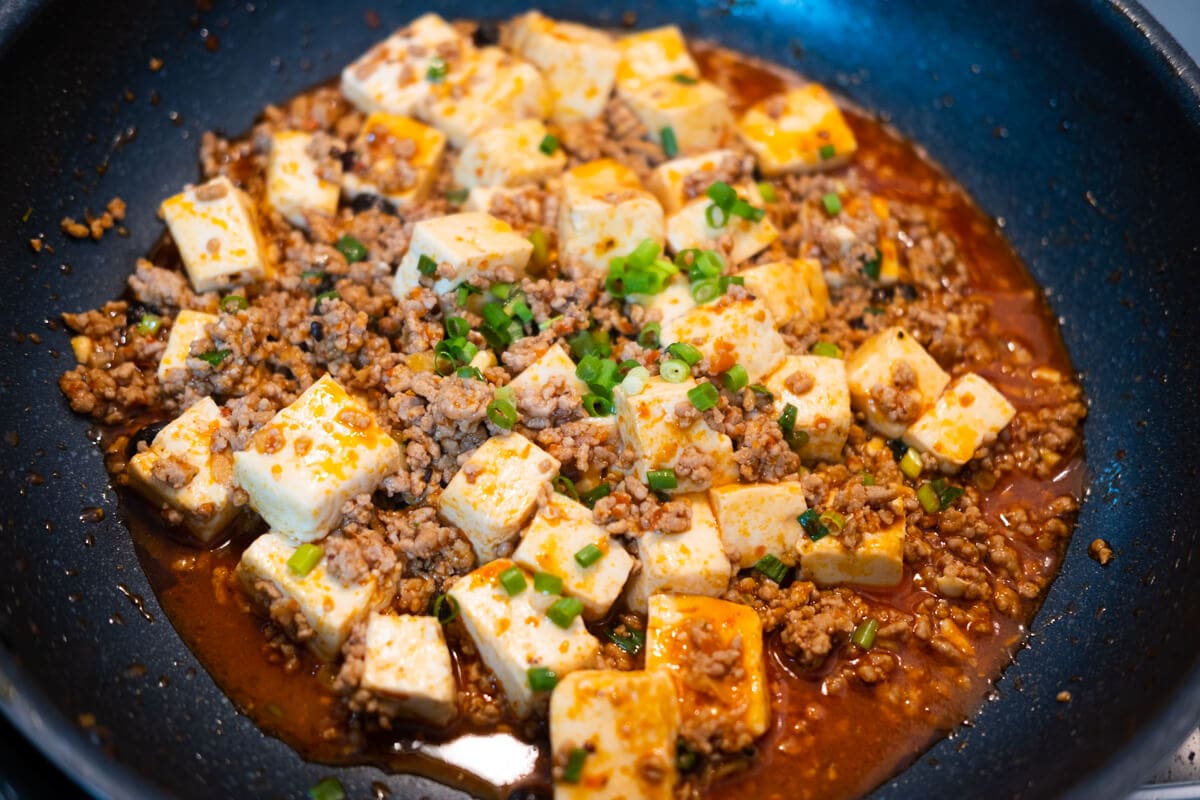
Step 3. Reduce the heat and simmer for about 3-5 minutes until the sauce thickens. Then, add roasted Sichuan peppercorn powder, chopped scallions, and add salt to taste. Gently stirring to blend everything well. Serve hot with steamed rice.
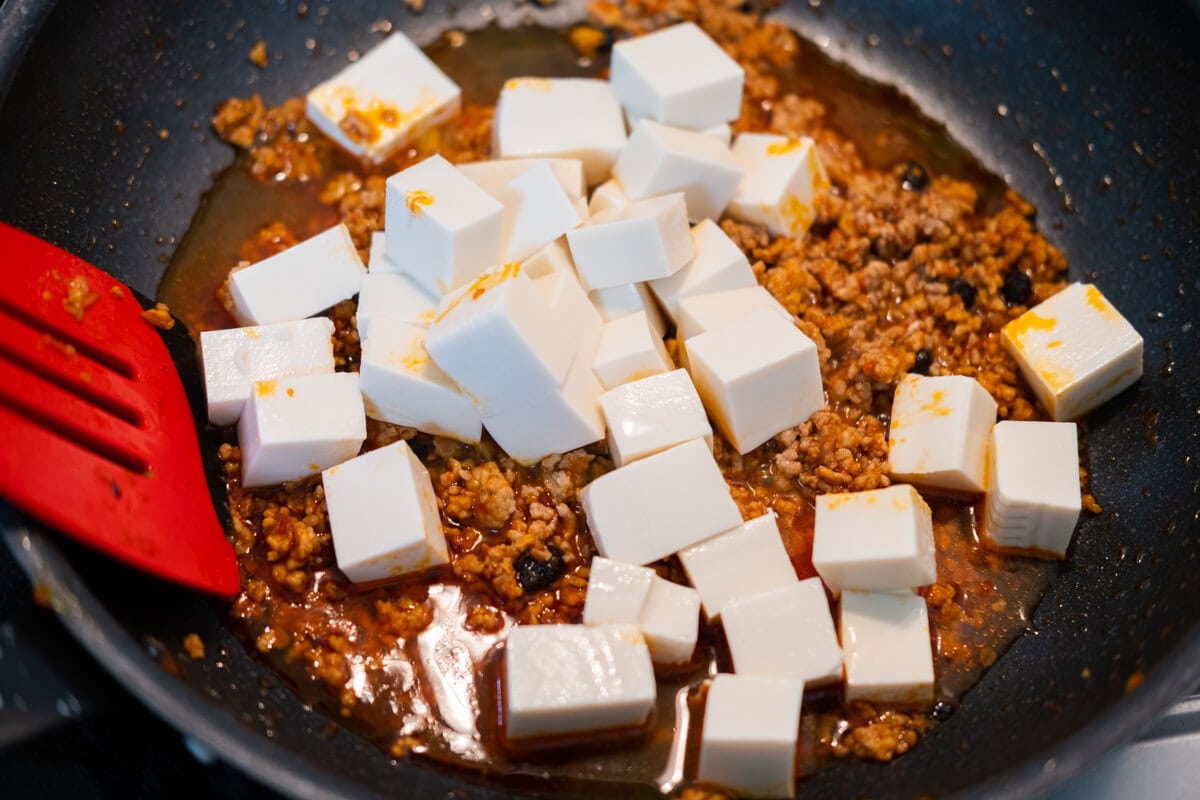
Step 2. Next, add chili powder, soy sauce, and fermented black beans, stir-frying until aromatic. Carefully add the tofu and water; gently stir to blend the tofu without breaking it, ensuring it mixes well with the sauce.
Helpful Tips For Home Cooks
I learned this Mapo Tofu recipe from my friend in Sichuan, so it’s as authentic as it gets. Please note, this recipe is spicy with strong and bold flavors.
- If you’re new to Chinese cooking, especially the mala flavors, consider reducing the amount of chili oil, chili powder, and Sichuan peppercorns.
- You can use firm tofu if you prefer a chewier texture.
- Prepare all the ingredients before starting to cook, as stir-frying happens quickly.
- Use a soft silicone spatula to gently stir-fry the tofu to prevent it from breaking.
- Remember to lower the heat while simmering the tofu with its sauce. This helps the tofu absorb the flavors without stirring too much and potentially breaking it.
By following the cooking tips above, you can create a delicious and authentic Mapo Tofu dish at home that rivals your favorite Chinese restaurant!
Frequently Asked Questions
Yes, you can make vegan or vegetarian Mapo Tofu by omitting the meat and using vegetable broth instead of water. You can also substitute minced mushrooms for the meat to add texture and umami flavors.
Traditional Mapo Tofu is known for its spicy and mala flavors. If you want it non-spicy, skip chili oil, chili powder and cut down on the spicy bean paste. If you don’t like the numbing flavor, skip the Sichuan peppercorns.
Soft or silken tofu is traditionally used for Mapo Tofu because it absorbs flavors well and has a delicate texture that contrasts nicely with the spicy sauce. Firm tofu can also be used for a chewier texture.
Sichuan peppercorn is an essential ingredient and traditional and authentic Mapo Tofu. They are not true peppercorns but dried husks of prickly ash berries. They impart a unique numbing (ma) sensation that complements the spicy (la) heat of the dish, creating a balanced flavor profile. If you do not like the tingly sensation in your mouth and palate, you may choose to skip it altogether.
This recipe is only 232 calories per serving.
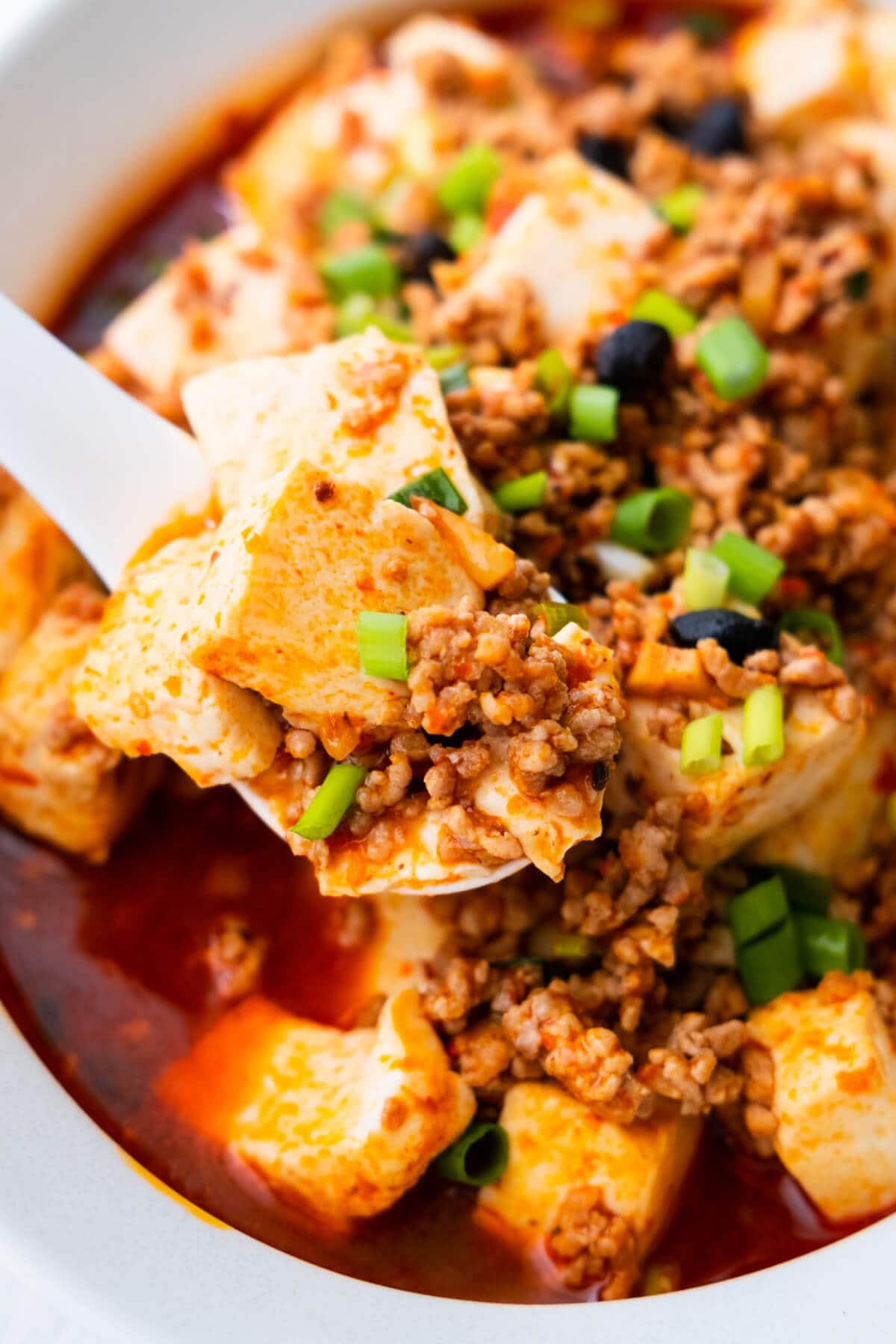
What To Serve With Mapo Tofu
The heat from the spices can be intense, making it perfect to pair with steamed rice to balance out the spiciness. I recommend the following dishes for a satisfying Chinese meal at home:
I hope you enjoy this post as much as I do. If you try my recipe, please leave a comment and consider giving it a 5-star rating. For more easy and delicious recipes, explore my Recipe Index, and stay updated by subscribing to my newsletter and following me on Facebook, Pinterest, and Instagram for new updates.
Other Recipes You Might Like

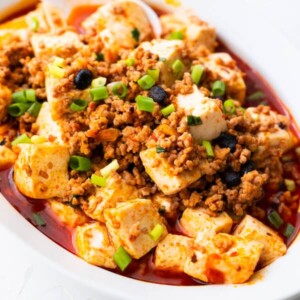
Mapo Tofu
Ingredients
- 1 block silken tofu, 18-oz/500 g
- 2 tablespoons cooking oil
- 2 tablespoons chili oil
- 2 cloves garlic, chopped
- 4 oz (113g) ground pork
Mapo Tofu Sauce
- 3 tablespoons Sichuan spicy bean paste , 辣豆瓣酱
- 1 tablespoons chili powder
- 1 tablespoon light soy sauce
- 1 teaspoon fermented black beans, rinsed and coarsely chopped
- 1/2 cup (125 ml) water
- 1 tablespoon Sichuan peppercorns, roasted and ground to powder
- 2 stalks leeks , or scallions, chopped
- salt , to taste
Instructions
- Cut the tofu into small pieces, drain any excess water from it, and set aside. Heat a wok, then add cooking oil and chili oil. Stir-fry chopped garlic, ground pork, and spicy bean paste until the pork is halfway cooked.
- Next, add chili powder, soy sauce, and fermented black beans, stir-frying until aromatic. Carefully add the tofu and water; gently stir to blend the tofu without breaking it, ensuring it mixes well with the sauce.
- Reduce the heat and simmer for about 3-5 minutes until the sauce thickens. Then, add roasted Sichuan peppercorn powder, chopped scallions, and add salt to taste. Gently stirring to blend everything well. Serve hot with steamed rice.
Notes
-
- If you’re new to Chinese cooking, especially the mala flavors, consider reducing the amount of chili oil, chili powder, and Sichuan peppercorns.
-
- You can use firm tofu if you prefer a chewier texture.
-
- Prepare all the ingredients before starting to cook, as stir-frying happens quickly.
-
- Use a soft silicone spatula to gently stir-fry the tofu to prevent it from breaking.
-
- Remember to lower the heat while simmering the tofu with its sauce. This helps the tofu absorb the flavors without stirring too much and potentially breaking it.
- In the United States, Chinese pantry ingredients can be purchased at large Asian supermarket chains like 99 Ranch Market and H Mart. For Spicy Bean sauce, I recommend the Lee Kum Kee brand, which is marketed as Chili Bean Sauce (Toban Djan).
Nutrition
Nutrition information is automatically calculated, so should only be used as an approximation.
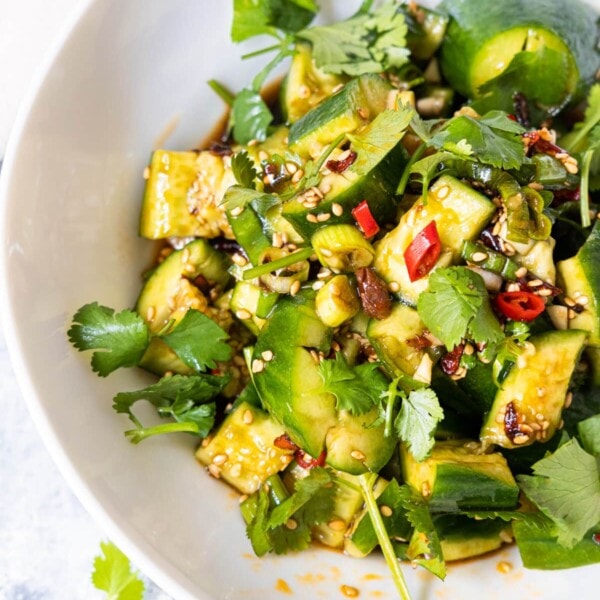
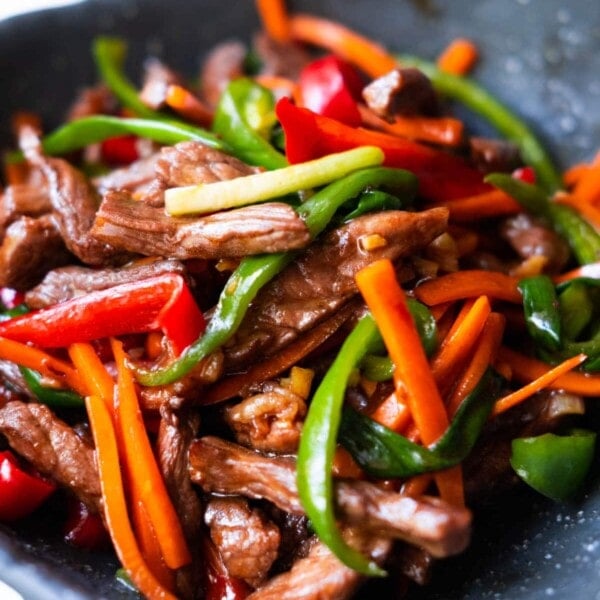
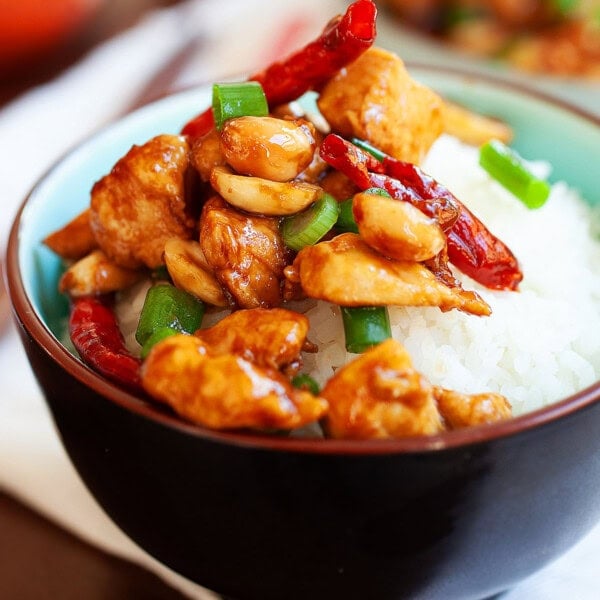
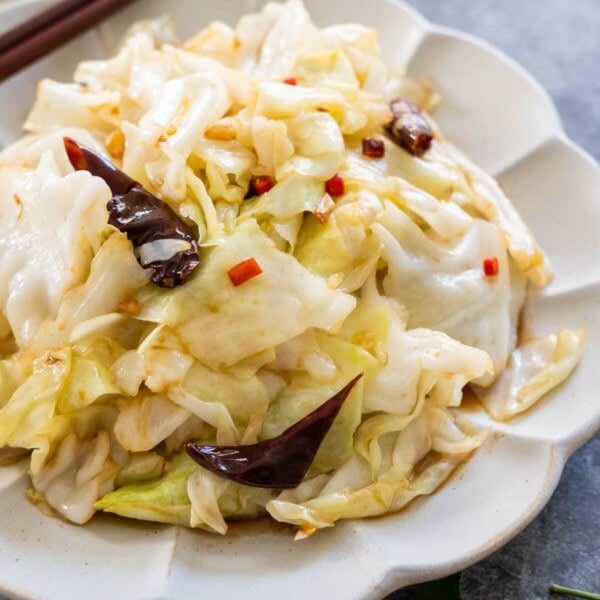






I like it.
What an awesome recipe! Easy to follow and delicious! I used Kashmiri chilli powder, pixian doubanjiang (spicy bean paste) and Laoganma chilli oil – the spiciness was just right with the measurements you recommended. I love your recipes- so authentic, pls keep them coming! Just wanted to ask more about the fermented black beans – it’s the same as salted black beans right?
thanks!
Hi Bee,
Your recipes never failed me! I halved this recipe for dinner, using Lao Gan Ma chilli flakes in oil for chilli oil and omitted the pork. I actually forgot to put the water in with the tofu and remembered to do it just before serving! After adding the water the sauce still looked runny so I added two tsps of corn starch made into slurry – the consistency came out right!
Spice level was just perfect for my husband and I. He polished off the sauce even without the rice!
Just want to say, thank you for the great recipe! Looking forward to exploring more on your website.
Hi Xuan, thanks for trying my recipe. Yes, please try more recipes on my site, for example: char siu and siu yuk and all the other recipes are easy and delicious: https://rasamalaysia.com/recipe-index-gallery/
This is a five stars recipes! Mapo Tofu is one of my family’s favorite dish. Bee, do you have a Chengdu Pork recipe? I had Chengdu Pork a few times in a Chinese restaurant, but now the restaurant is not offering the dish.
Thank You
What kink of chili powder? Is it American, korean, Thai, etc?
Doesn’t matter.
Hi, I’ve been making this recipe for many, many years now, its by far still the best Mapo Tofu I’ve ever eaten. But I have made some changes to it, especially in regards to the chili powder. I am really curious: is it really supposed to be 2 tablespoons? What kind of chili powder is it? When first making this, I used the red chili powder you typically find at the Asian food market. When I first made this recipe, I found that 2 tablespoons of chili powder was PAINFUL. And not just to my Western palette. I have fed this dish to many Han Chinese foreign college students. I watched a spicy-food-loving Sichuan native shove ice cubes in his mouth after eating the dish when I used the “correct” amount of chili powder. I don’t believe ANYBODY short of Chili Klaus could eat this dish comfortably.
I still use 2 tablespoons now, but exclusively ancho chili powder, so it still has the flavor but without setting everybody’s mouth on fire. Once I switched to ancho this dish became absolutely amazing, and STILL quite spicy from the chili oil and spicy bean paste. I am SO curious if I was always doing something wrong back then. As this recipe is something I make quite frequently I just had to come back after so many years and ask this. I think this about every time I make this recipe. So: is it really supposed to be 2 tablespoons of red chili powder?
Yes two tablespoon of red chili powder. There are many different types of chili powder some super spicy and some are just red and not much heat. Yes acho is the way to go or Korean chili powder. Certainly not going to use cayenne pepper.
Mapo tofu is one of my favorite foods in the entire world, and this recipe makes a fantastic mapo tofu! Thank you so much for sharing it!
Me too! My daughter has a pork allergy so I made an extra batch for her with ground (light and dark) chicken. She loved it!
Hi Rasa,
I’ve been wanting to make Mapo Tofu for ages, and I finally decided it’s time to put some action in it.
Your recipe appeals to me most, but I don’t quite understand how much a block of tofu weighs. I buy mine fresh at the Asian supermarket close to where I live, and since I live in the Netherlands, it’s not the first time I’m having a hard time understanding foreign measurements on the internet.
Thanks in advance for helping me out!
Hi Mirjam, the ones we have here is about 12-16 oz
We also live in NL and I would not recommend the fresh tofu from the toko. We much prefer the silken tofu
I absolutely love your Nonya recipes. Several year of living in Singapore with meals regularly taken at gourmet place as Orchard Rd Car Park, Albert Street and Newton Circus. Whenever I can I try to duplicate those flavors this leads me to a questin: when you call for “chili powder”, what exactly do you mean”. There are several choices: chili powder as is used in Mexican cuisine (usually a mix of long red, ancho & pasilla chilis; cayenne and straight red pepper powder from dried long reds. In the quantities called for in most Asian recipes cayenne is way too much, the Mexican powder probably does not offer the right flavor leaving only red pepper powder or so it seems.
What ami missing?
Thanks much.
Terimah kaso
Jb